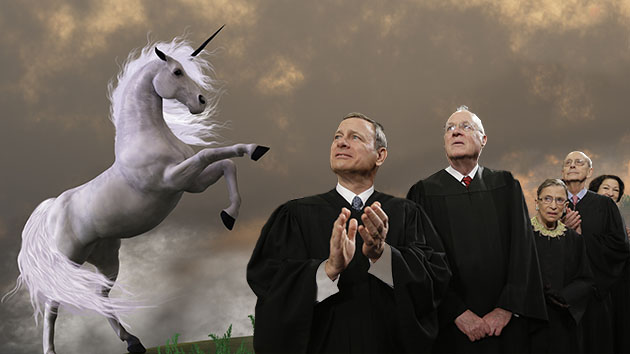
Supreme Court plaintiff Abigail Fisher and Edward Blum, the man who recruited her to challenge affirmative action at the University of TexasAP Photo/J. Scott Applewhite
Apparently Abigail Fisher is going to stay mad. #StayMadAbby is the Twitter hashtag Fisher earned during the course of her long-running lawsuit against the University of Texas-Austin when she alleged that the flagship Texas university had discriminated against her, a white woman, when it denied her admission in favor of less qualified black students. In June, the Supreme Court ruled 4-3 against her, ending eight years of litigation that extended long after Fisher had graduated from Louisiana State.
Now that her legal saga is over, it seems Fisher hasn’t given up attacking affirmative action. She’s become a board member of Students for Fair Admissions, a group founded and run by former Texas stockbroker Edward Blum, the same man who recruited her to file suit against the University of Texas. Blum has made a name for himself by ginning up lawsuits challenging racial preferences in various forums, including college admissions and legislative redistricting. Many of those cases, like Fisher’s, have ended up at the Supreme Court. Another one of Blum’s cases, Shelby County v. Holder, resulted in a decision gutting a significant section of the historic Voting Rights Act.
But Blum’s record has been decidedly mixed. He’s succeeded in getting many cases before the high court, but he hasn’t won many of them. One reason may be that he has recruited plaintiffs in those cases who, like Fisher, aren’t particularly sympathetic characters and who don’t have a compelling story of discrimination. One plaintiff in Blum’s other Supreme Court case this term, Evenwel v Abbott, challenging Texas’s legislative district-drawing process, had posted YouTube videos expressing his views that the Earth doesn’t revolve around the sun and that unicorns are real. (The man, Edward Pfenninger, was also a board member of Blum’s nonprofit group, Project on Fair Representation.) Another Evenwel plaintiff had helped promote the movie Dreams From My Real Father: A Story of Reds and Deception, suggesting President Barack Obama’s father was actually a Communist propagandist named Frank Marshall Davis.
Apparently, recruiting sympathetic white people who have legitimate claims of discrimination and are also interested in making life harder for minorities is a tough job. So Blum has embarked on a different strategy. He’s enlisted a new group of people to focus on in his crusade against racial preferences: Asian American students. Blum has argued that affirmative action policies negatively affect extremely well-qualified Asian American students, whom he argues are being rejected from prestigious schools in favor of less qualified applicants of other races.
In 2014, he created Students for Fair Admissions, a group purported to represent extremely well-qualified rejects from prestigious schools, such as Harvard, as well as their parents and potential applicants to those schools. That same year the group filed suit against Harvard University and the University of North Carolina, arguing that the schools discriminate against Asian American applicants. The cases have been considered sleeper challenges to affirmative action, with far more potential to succeed than Fisher’s case, largely because of the sympathetic victims. In his dissent in Fisher’s case, Justice Samuel Alito even seemed to give the cases a boost toward the high court when he invoked Asian American students as examples of how he believed affirmative action led to discrimination. The cases had been on hold, awaiting the resolution of Fisher’s case, but they are now moving forward, with help from Fisher herself.
That may be a mixed blessing. During the course of Fisher’s two trips to the Supreme Court, the university disclosed that her grades were such that she would not have been admitted to the school regardless of her race. (Her school record has earned her the Twitter hashtag #BeckyWithTheBadGrades.) As such, lawyers had argued that Fisher didn’t appear to have standing, or the right, to bring the case because she couldn’t show any identifiable injury. But the court proceeded with it anyway; it has a long record of bending over backward to allow white plaintiffs to challenge affirmative action in a manner not accorded to African Americans bringing discrimination lawsuits.
Blum seems to have solved his past plaintiff problem in Students for Fair Admissions cases by not having a real person headline the case. SFFA is the plaintiff in the cases, and no Asian American college applicant has come forward to provide a public face. (In the lawsuit against UNC, the only member of the group described in the lawsuit as a victim of discrimination is white.) Until this year, the group apparently had only an all-white board, consisting of Blum, Fisher, and her dad, who’s an old friend of Blum’s.
Harvard has fought back hard over this level of secrecy, raising questions about whether Blum’s group has standing to bring the case, and whether it really represents anyone who can claim a legitimate injury. As you might expect, Harvard has an all-star legal defense team that includes former Solicitor General Seth Waxman and Debo Adegbile, a former litigation director of the NAACP Legal Defense and Educational Fund. This team has been pushing hard to force Blum to release far more information than he has about the rejected students it claims to represent, and the membership and leadership of his organization. What SFFA has released has been done under a protective order so only the parties in the case can see it. Recently, the group added two other board members, Edward Chen and JZ “Joe” Zhou. Blum resisted providing more information to Harvard about who exactly these men are. Blum also declined to comment for this story and would not provide any details about the board members to Mother Jones.
Blum is arguing in court that he shouldn’t have to disclose more because such disclosures could subject his clients to harassment and threats of physical violence. Exhibit A for this argument is Fisher, who has provided an affidavit in the case outlining the “consistent harassment” she endured while suing UT. She lists the negative news coverage of her case. (Jezebel‘s “Noted Dummy Abigail Fisher’s Rights Weren’t Violated, Rules Court” is high on the list.)
People were also mean to her on Twitter, she says in the affidavit, highlighting the #StayMadAbby campaign, and quoting some of the nasty tweets she received: “#StayMadAbby…bitch kill yourself”—”Dear Bitch, If you’re stupid of course you aren’t going to get into a school. Dumb ass racist.” She says people recognize her in public and say mean things to her about her case, which makes her feel “uneasy at times even to go out in public.” Worst of all, perhaps, reporters have hounded her, even contacting members of her Louisiana State bowling team. “I understood that being a plaintiff came with risks, but it would not be fair for someone who expected confidentiality and did not volunteer for a public role to endure anything like what I have gone through because of my participation in the Fisher case,” she says in her statement.
Blum has also argued that Asian Americans would be deterred from joining his cause if they were forced to go public. As evidence, he has submitted an anonymous affidavit from a John Doe who says he fears that if his involvement with SFFA were to become public, it might keep his six-year-old son from getting into Harvard. “I hope that my son can someday attend Harvard and fear that if Harvard knew that I opposed its undergraduate admissions policies, then it might later retaliate against me by denying admission to my son,” he writes.
It’s not clear that Asian Americans have responded to Blum’s quest with great enthusiasm. Asian American civil rights groups have come out strongly in favor of affirmative action, with their own hashtag, #IAmNotYourWedge, arguing that Blum is simply using Asian students to advance an agenda that’s squarely aimed at harming African Americans.
A coalition of such groups has publicly disagreed that Harvard discriminates against Asians, and notes that 21 percent of its student body in the class of 2019 is Asian American, roughly four times higher than their percentage in the general population, and also a figure that corresponds exactly with the percentage of applicants who were Asian American. They also argue that affirmative action helps Asian and Pacific Islanders in the admissions process.
At the same time, even civil rights groups opposed to Blum’s case are wary of Harvard’s push for more disclosure about his group’s membership. Significant First Amendment rights of association are in play. Civil rights groups have long fought similar efforts to force them to disclose their members out of very real fears for the safety of those members. In the 1950s, the state of Alabama tried to force the NAACP to disclose all its members as a way of keeping it from operating in the state. The Supreme Court ruled in 1958, in NAACP v. Alabama, that Alabama had overstepped its authority and that such a demand would suppress the NAACP’s members’ rights to associate.
Blum’s case is much different, and Harvard’s discovery requests involve whether his members even have the right to bring a discrimination case. Nonetheless, Jon Greenbaum, chief counsel for the civil rights group Lawyers Committee on Civil Rights Under Law, which represents African Americans and other ethnic minorities and has frequently opposed Blum’s lawsuits, says, “I’m on the same side [as Blum] in terms of the idea. We have run into these issues before where defendants want to dig down and get membership lists. It’s something we are resistant to.”
Greenbaum’s organization represented a group of minority Harvard students who tried to intervene in the SFFA case to represent students who they said would be harmed by the race-neutral policies SFFA was pushing. The effort failed, but Greenbaum says, unlike Blum, he had no trouble finding clients who were willing to be publicly identified as supporting affirmative action.
He understands Fisher’s complaints about harassment, which his clients have also suffered. “In a general way, conceptually, I have sympathy for what people go through when they put themselves on a complaint as plaintiffs in a case that’s going to get a lot of attention,” he said. “At the same time, if you’re going to create an organization that’s going to exist, and it’s purpose is to do a particular thing, the organization has to be real. It can’t just be lawyers and particular advocates like Ed Blum bringing this case. I think it’s strange to have a situation where nobody’s coming forward, where you don’t have an individual identifying themselves with the cause.”














